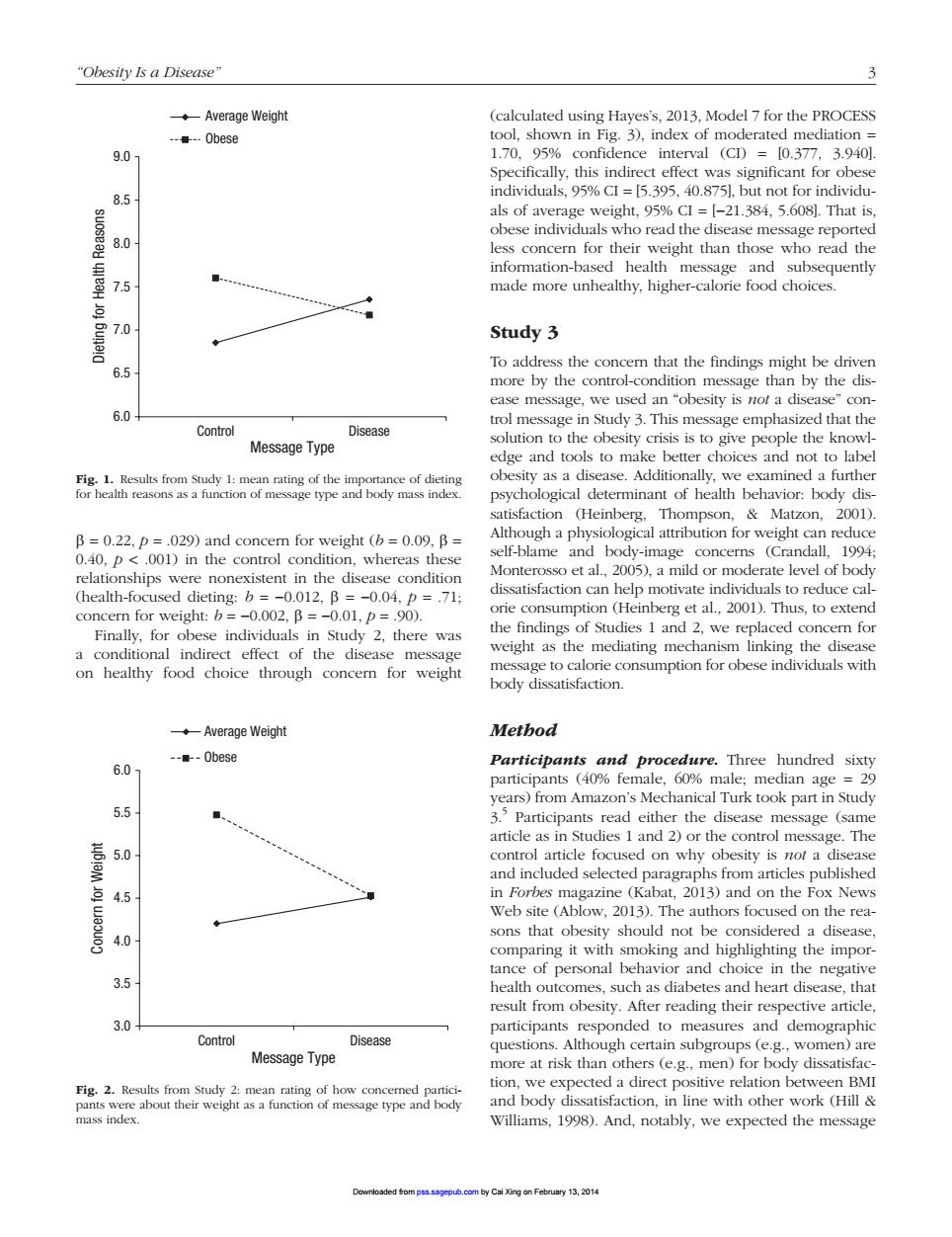正在加载图片...

"Obesity Is a Disease" 3 Average Weight (calculated using Hayes's,2013,Model 7 for the PROCESS -Obese 9.0 1.70 nce interval (CI)=[0.37 )40 8.5 als of average weight,95%CI=[-21.384,5.608).That is, 8.0 obese individuals who read the disease message reported less concern for their weight than thos Study 3 65 case me ge we used an "obesity is not a disease"con 6.0 trol message in Study 3.This message emphasized that the Control Disease Message Type to the obesity crisis is to give people theknow e and not torthe psvchological determinant of health behavior:body dis satisfaction (Heinberg.Thompson,Matzon,2001). relationships were nonexistent in the disease condition dissatisfaction can help motivate individuals to reduce cal (health-focused dieting:b=-0.012.B =-0.04,p=.71; orie consumption (Heinberg et al.,2001).Thus,to extend concem for weight:b -0.002,B=-0.01,p= 0 wa the findings of Studies I and 2,we replaced concern for weight as th on healthy food choice through concem for weight Average Weight Metbod ---Obese 60 hree mal poartons nedian ag Participants read either the disease message (same article as and 2)or t ol n Th 50 4.5 in Forbes magazine (Kabat,2013)and on the Fox News Web site (Ablow,2013).The authors focused on the rea 540 sons that obes should not b dered disease 35 health outcomes.such as diabetes and heart disease.that result from obesity.After reading their respective article 3.0 participants nded to measures and demographic Control Message Type tion,we expected a direct positive relation between BMI and body dissatisfaction,in line with other work (Hill mass index Williams,1998).And,notably,we expected the message“Obesity Is a Disease” 3 β = 0.22, p = .029) and concern for weight (b = 0.09, β = 0.40, p < .001) in the control condition, whereas these relationships were nonexistent in the disease condition (health-focused dieting: b = −0.012, β = −0.04, p = .71; concern for weight: b = −0.002, β = −0.01, p = .90). Finally, for obese individuals in Study 2, there was a conditional indirect effect of the disease message on healthy food choice through concern for weight (calculated using Hayes’s, 2013, Model 7 for the PROCESS tool, shown in Fig. 3), index of moderated mediation = 1.70, 95% confidence interval (CI) = [0.377, 3.940]. Specifically, this indirect effect was significant for obese individuals, 95% CI = [5.395, 40.875], but not for individuals of average weight, 95% CI = [−21.384, 5.608]. That is, obese individuals who read the disease message reported less concern for their weight than those who read the information-based health message and subsequently made more unhealthy, higher-calorie food choices. Study 3 To address the concern that the findings might be driven more by the control-condition message than by the disease message, we used an “obesity is not a disease” control message in Study 3. This message emphasized that the solution to the obesity crisis is to give people the knowledge and tools to make better choices and not to label obesity as a disease. Additionally, we examined a further psychological determinant of health behavior: body dissatisfaction (Heinberg, Thompson, & Matzon, 2001). Although a physiological attribution for weight can reduce self-blame and body-image concerns (Crandall, 1994; Monterosso et al., 2005), a mild or moderate level of body dissatisfaction can help motivate individuals to reduce calorie consumption (Heinberg et al., 2001). Thus, to extend the findings of Studies 1 and 2, we replaced concern for weight as the mediating mechanism linking the disease message to calorie consumption for obese individuals with body dissatisfaction. Method Participants and procedure. Three hundred sixty participants (40% female, 60% male; median age = 29 years) from Amazon’s Mechanical Turk took part in Study 3.5 Participants read either the disease message (same article as in Studies 1 and 2) or the control message. The control article focused on why obesity is not a disease and included selected paragraphs from articles published in Forbes magazine (Kabat, 2013) and on the Fox News Web site (Ablow, 2013). The authors focused on the reasons that obesity should not be considered a disease, comparing it with smoking and highlighting the importance of personal behavior and choice in the negative health outcomes, such as diabetes and heart disease, that result from obesity. After reading their respective article, participants responded to measures and demographic questions. Although certain subgroups (e.g., women) are more at risk than others (e.g., men) for body dissatisfaction, we expected a direct positive relation between BMI and body dissatisfaction, in line with other work (Hill & Williams, 1998). And, notably, we expected the message 6.0 6.5 7.0 7.5 8.0 8.5 9.0 Control Disease Dieting for Health Reasons Message Type Average Weight Obese Fig. 1. Results from Study 1: mean rating of the importance of dieting for health reasons as a function of message type and body mass index. 3.0 3.5 4.0 4.5 5.0 5.5 6.0 Control Disease Concern for Weight Message Type Average Weight Obese Fig. 2. Results from Study 2: mean rating of how concerned participants were about their weight as a function of message type and body mass index. Downloaded from pss.sagepub.com by Cai Xing on February 13, 2014